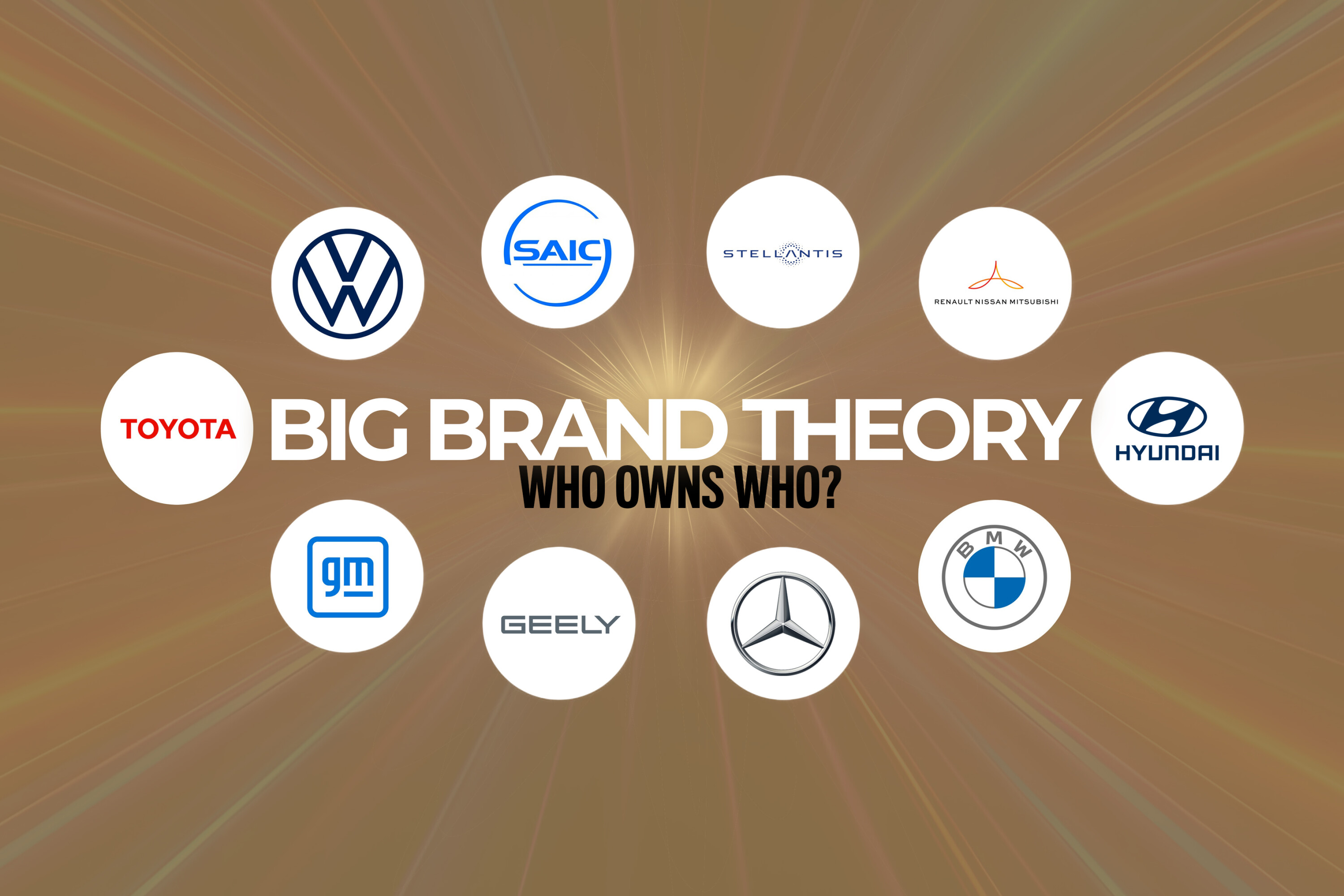
Most people know Lexus is Toyota’s luxury arm, and BMW owns Mini, but did you know Lamborghini is owned by Audi, which in turn is owned by Volkswagen? Or that, before its eventual demise as a carmaker, Holden started out making saddles?
Here is the current status of every major car brand, as well as a snippet of its history and when it was founded.
In most cases, the nationality of the current owner is a matter of semantics. For example, just because Jaguar is currently under Indian ownership, the brand is no less British than it has been in all its years.
You’ll often find the head office, design centres and sometimes even the factories stay in their respective native countries regardless of who now owns a given brand.
Car companies shift ownership more frequently than you might imagine, and part ownership shares even more often than that, so it can be difficult to keep track. This is as the global automotive landscape looks at the time of writing.

Toyota – Founded 1937
Australia’s favourite car brand by sales, Toyota continues to rank at the top of the big three, a significant way ahead of Mazda in second place – while Ford, Hyundai and Mitsubishi tussle for the remaining spots in the top five.
The company produces about 10 million cars each year and is a world leader in the hybrid market, having surpassed a total of 200,000 hybrid sales in Australia between 2001 and 2021. Toyota also produces heavy commercial vehicles under the Hino brand.
Lexus – Founded 1989
Lexus was established in the late ’80s to serve as Toyota’s luxury vehicle division. In Australia, the brand has thrived, and it now has an 11-model line-up Down Under, including the BMW-tackling IS and RC, a more recent LC halo sportscar and a growing range of SUVs.
Some other brands have tried to repeat the Lexus success story with their own luxury branches, but none has yet equalled the results.
Daihatsu – Founded 1907
Daihatsu is a new name under the Toyota umbrella, becoming wholly-owned as of August 2016. Originally formed back in 1907 under the name Hatsudoki Seizo, the company was renamed Daihatsu in 1951.
The last new model introduced to Australia was the Sirion but Toyota pulled the brand here in 2005.
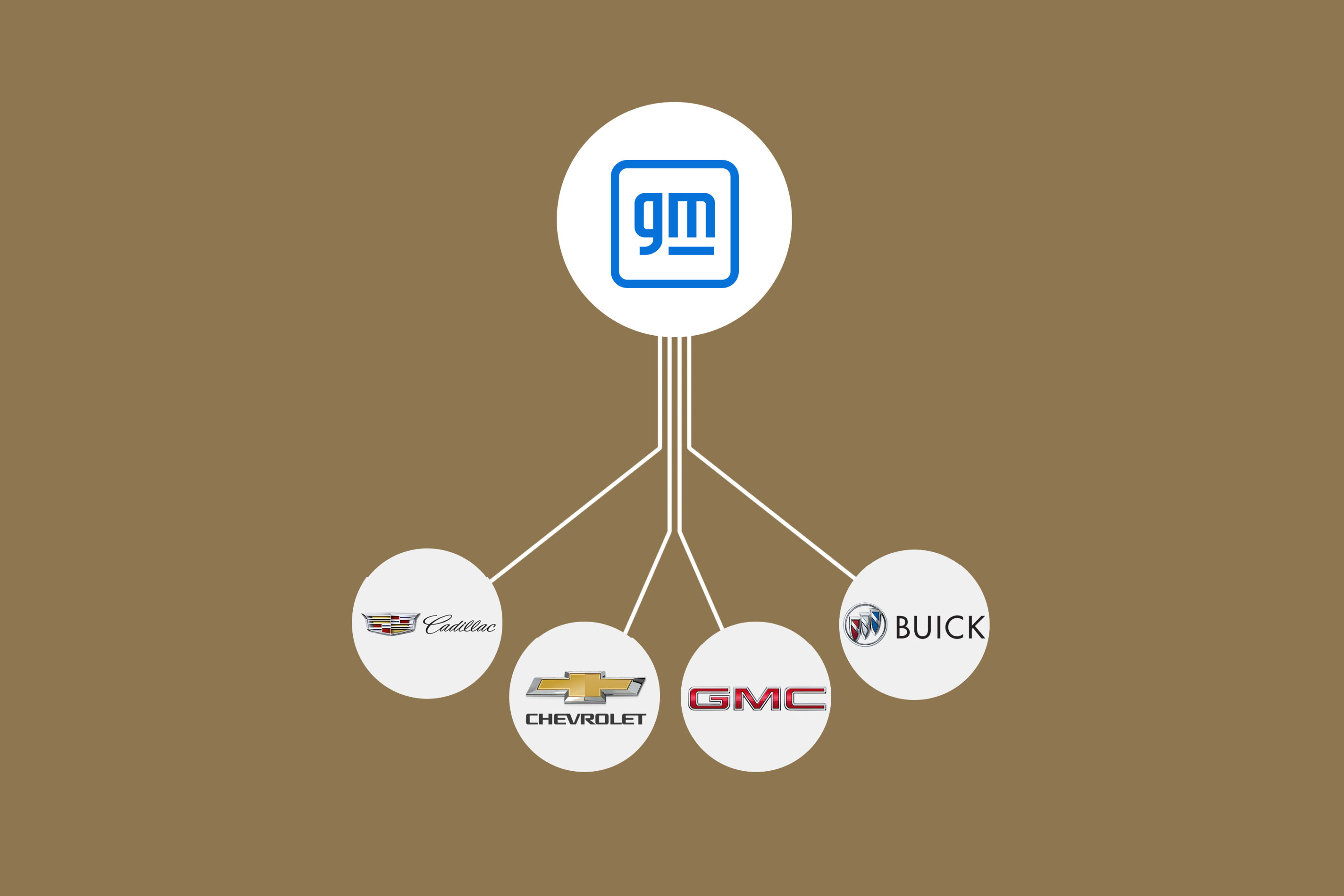
General Motors – Founded 1908
Abbreviated to simply GM, this car giant is the largest in America and builds vehicles under numerous global marques.
Founded more than 110 years ago, the company now produces cars in 15 different countries and is still based in Detroit.
Chevrolet – Founded 1911
Following something of a struggle, Chevrolet became a part of General Motors in 1918, before being designated as GM’s flagship brand in 1919. After a tenuous relationship with Australia, the swiss-cross badge has a presence on the nose of the Camaro and Silverado, which are converted locally in right-hand drive form by General Motors Special Vehicles (GMSV).
Buick – Founded 1899
Buick was absorbed into GM upon its creation in 1908, by the then owner of the company as well as GM’s William C. Durant. Despite recovering after a GFC-inflicted low sales year in 2009, Buick sales hit a ten-year low in 2020, dropping over 20 per cent on the year before.
Cadillac – Founded 1902
Cadillac is often regarded as GM’s luxury marque and was acquired by the company in 1909. Today though, the brand forges a position for itself with an ‘art and science’ design philosophy, across a range of sedans, roadsters, crossovers and SUVs.
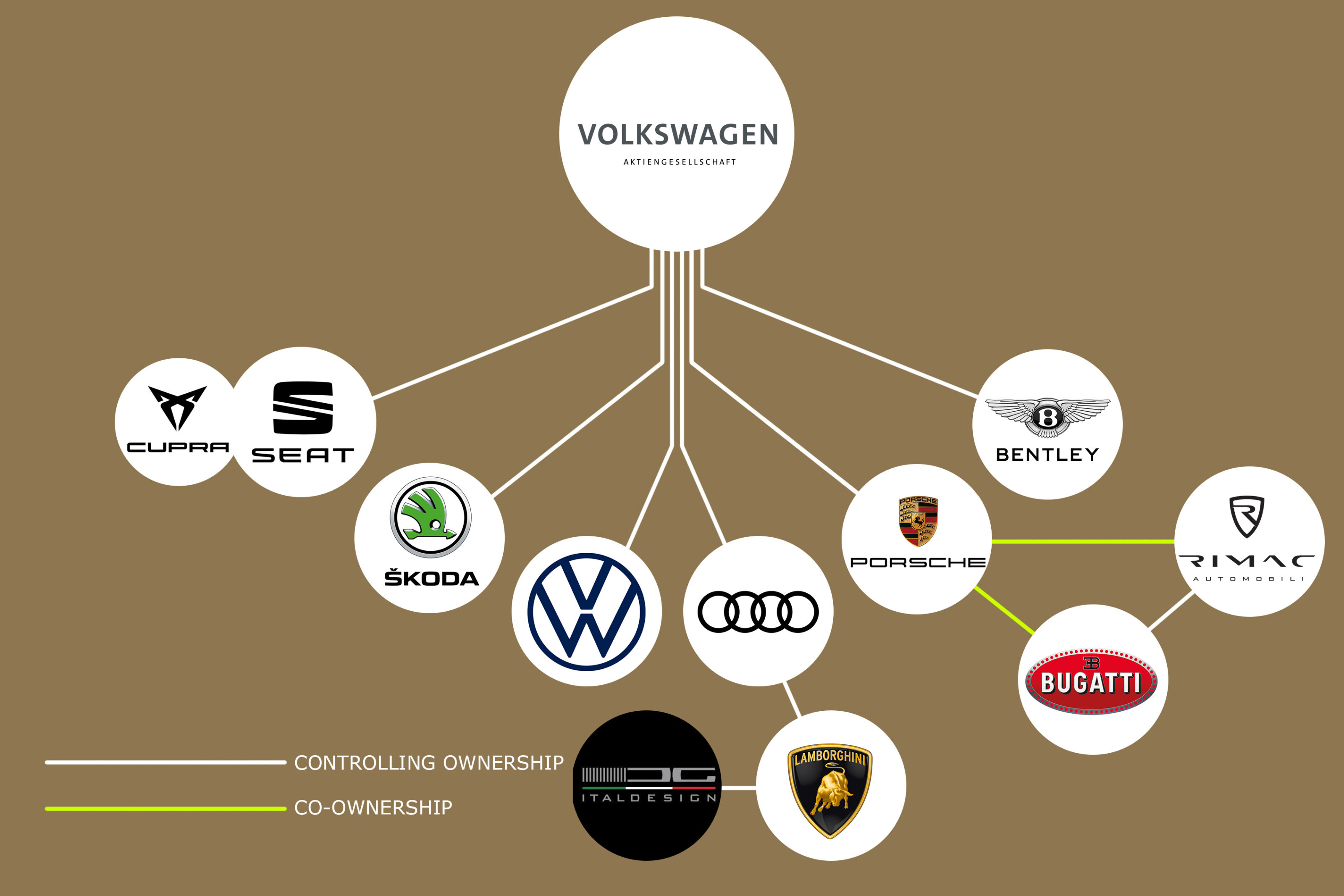
Volkswagen – Founded 1937
VW was founded by the German Labour Front (yes, the Nazis) with the goal of making a car for the German populace. From this came the Beetle.
The Beetle was sold from 1938 until 2003, making it the longest-running and most manufactured car of all time; especially if you regard the ‘New Beetle’ a continuation of its bloodline, which added another 16 years to the lifespan.
Audi – Founded 1910
Audi, previously managed by Daimler Benz, came under the control of VW in the 1960s. With the Audi name kept dormant for a period of 25 years under Daimler, it was revived in 1965. Today, the brand is one of the world’s leading premium manufacturers.
Lamborghini – Founded 1963
Today, Lamborghini is owned in its entirety by Audi, which, as of 2011, provided the stability of its backing. The brand currently produces some of the most desirable cars in the world, including the Huracan, Aventador and more recently, its Urus SUV.
Bentley – Founded 1919
The British company known for its luxury sports tourers was a standalone company for 12 years before being taken over by Rolls-Royce. Then, when Rolls went bankrupt in 1980, Bentley was sold to Vickers PLC. Finally VW revived the brand when it was purchased in 1998.
Bugatti-Rimac – 1909/2009
Bugatti was originally known for its design beauty, founded by the Italian artist and constructor Ettore Bugatti. However, after Ettore died in 1947, the company fell apart and became defunct as a carmaker in the 1960s. It was revived in 1987 for a few years by Italian entrepreneur Romano Artioli, and then eventually acquired by VW in 1998.
Rimac is a Croatian company, named after founder Mate Rimac, which has become well-known for its advanced battery and electric vehicle technology. Though Porsche owns a 24 per cent stake in Rimac, a deal was struck in July 2021 for the VW Group to access more of Rimac’s tech in exchange for a 55 per cent share in Bugatti, making Mate Rimac the CEO of the company at age 33.
Skoda – Founded 1895
Not fully controlled by VW until 2000, Skoda was aimed at being the group’s entry-level brand, providing cheaper cars than that of Volkswagen, yet using engines and technology common to both marques. Clever design ideas have helped the brand to retain its own identity.
Porsche – Founded 1931
After decades operating independently and as one of the world’s most profitable car companies, Porsche was eventually swallowed whole by Volkswagen in 2012. It followed four years of attempts by Volkswagen to acquire the company, during which time it succeeded in buying 49.9 per cent.
The ultimate settlement and merger hid an ugly power struggle in which both companies tried to buy out each other with Volkswagen emerging the victor.
Seat – Founded 1950
Owned by the Spanish Government from 1950 to 1986, the Volkswagen Group took a 51 per cent share in Seat before acquiring 99.99 per cent of the company in 1990. Only active in Australia between 1997 and 1999, the Spanish company will be returning in 2022 but only with its performance division, Cupra.
Cupra – Founded 1985
Initially formed as Seat Sport, the motorsport division of the Spanish manufacturer underwent a rebrand in 2018 when it was renamed Cupra. As the Volkswagen Group’s dedicated performance company, Cupra will be coming to Australia this year with a range of re-dressed, high-performance VW, Audi and Skoda models.

Stellantis – Founded 2021
A super-stable born off the back of two pre-existing conglomerates coming together.
Stellantis was formed in January 2021 as a multinational merger between Fiat Chrysler Automobiles (FCA) and Groupe PSA.
Fiat (FCA) – Founded 1899
Italy’s largest car brand, while not particularly prominent in Australia, is a powerhouse in Europe. Fiat is best known for its small cars including the Panda, Punto and retro-styled 500, the latter of which is available in Australia.
Abarth (FCA) – Founded 1949
Abarth was formerly a standalone road and racing car producer before its founder, Carlo, sold the company to Fiat in 1971. By 1981 the brand ended production until it was revived in 2007.
In Europe, the 124 Spider is sold as a more affordable Fiat-badged version, but in Australia, only the most powerful Abarth 124 is offered. You can also find high-performance versions of the 500 wearing the same scorpion badge.
Chrysler (FCA) – Founded 1925
Chrysler is one of America’s largest car manufacturers. However, it had to be saved, primarily by Fiat, in 2009, following the US automotive industry crisis. Fiat then took full ownership of the American brand in 2014.
Only one Chrysler model is currently sold in Australia – the 300 large sedan.
Dodge (FCA) – Founded 1900
Under the Chrysler umbrella, Dodge became a subsidiary of the Fiat group in 2009, having also previously been involved with Daimler. Dodge is responsible for both the RAM and SRT subdivisions, RAM being for its large 4×4 trucks and SRT for performance cars.
Jeep (FCA) – Founded 1941
Jeep is perhaps best known for its small durable 4×4 vehicles built specifically for the US military. Civilian models then became available in 1945.
The company has been owned by several brands, including AMC (with Renault), Chrysler, Daimler, and now Fiat. Among many company icons, the seven-slot grille is perhaps the most famous and is worn by every model.
Alfa Romeo (FCA)– Founded 1910
The Italian brand known for its sports cars and racing exploits was founded more than a century ago. Alfa Romeo became a part of FCA in 2007, currently only producing two cars for sale in Australia, the Giulia and Stelvio.
Lancia (FCA) – Founded 1906
Despite being sold only in Italy in modern times, Lancia is still a well-known brand thanks to its highly successful motorsport endeavours, including famous rally cars like the Stratos, Delta and 037. It came under the Fiat umbrella in 1969.
Peugeot (PSA) – Founded 1810
Originally a coffee mill company, Peugeot switched to bicycles in 1830 before looking to cars in 1882, and eventually becoming a highly successful mainstream vehicle producer. In 2014, the French Government and Dongfeng Motors both purchased 14 per cent stakes in the company.
Citroën (PSA) – Founded 1919
Citroën has made waves in the automotive world at various points during its lifetime, and today is best known for quirky small and mid-sized cars. The brand was taken over by Peugeot in 1976.
Opel (PSA) – Founded 1863
Opel was originally founded in 1863 to produce sewing machines. It then took on bicycles in 1886 and automobiles in 1899. GM would then move to take a majority stake in the German brand in 1929 and increased to full control from 1931.
As of 2017, PSA Group took over the brand along with Vauxhall as part of the deal.
Vauxhall (PSA) – Founded 1857
Vauxhall was founded in 1857 in the UK as a pump and marine engine manufacturer before turning its hand to cars in 1903.
It was later acquired by GM in 1925 and from 1980 was rebadged, and sold largely the same product in the UK as Opel has in Germany and other parts of Europe. It too joined PSA at the same time as Opel in 2017.
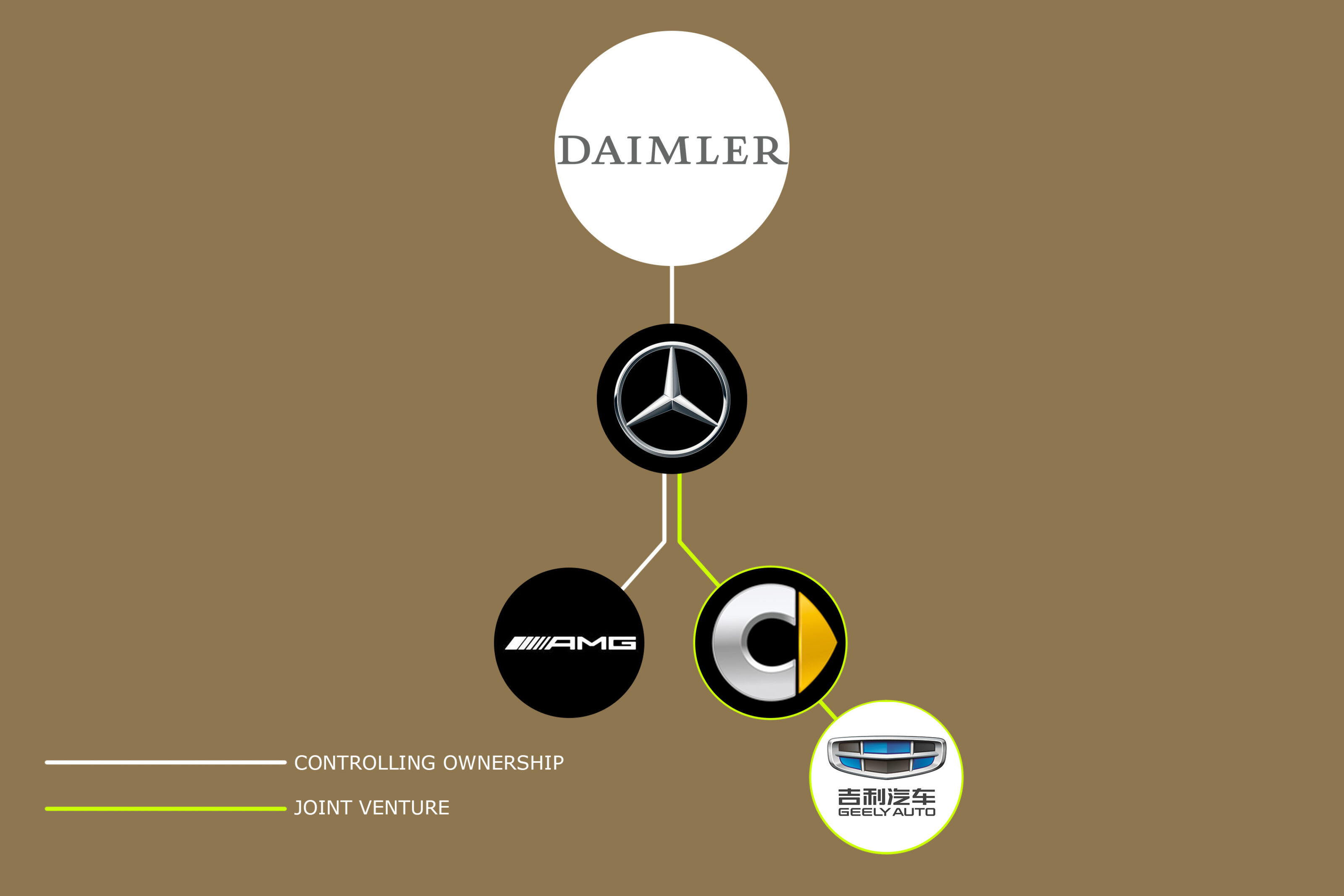
Mercedes-Benz Group (formerly Daimler) – Founded 1926
Daimler is a German automaker that sells its vehicles under the world-renowned Mercedes-Benz brand. The company was formed with the merging of the Daimler and Benz auto companies, before purchasing Chrysler in 1998 and being named Daimler Chrysler AG.
After later selling off the US brand in 2007, it became known simply as Daimler AG.
Mercedes-Benz – Founded 1883
Mercedes-Benz is the world’s oldest car manufacturer. Today the brand is best known for its wide range of luxury cars and its high-performance car division called AMG – as well as its participation in Formula 1, having won the Constructors Championship every year from 2014 to 2020.
Smart – Founded 1994
Smart is a Daimler AG brand that exclusively produces microcars and subcompacts. Originally just an idea by the head of Swiss timepiece manufacturer Swatch, the company and Mercedes came to an agreement the same year to build cars.
The brand was withdrawn from the Australian market in 2015 due to dwindling sales.
In 2019, Daimler and Geely announced a joint venture to produce Smart cars in China for global distribution.
Maybach – Founded 1909
Maybach was acquired by Daimler in 1960, becoming the company’s ultra-luxury brand and in direct competition with Rolls Royce. However, poor sales meant the marque was put into stasis in 2012.
It was then revived in 2015 as ‘Mercedes-Maybach’ with a range of models more closely related to Mercedes vehicles than in its previous life.
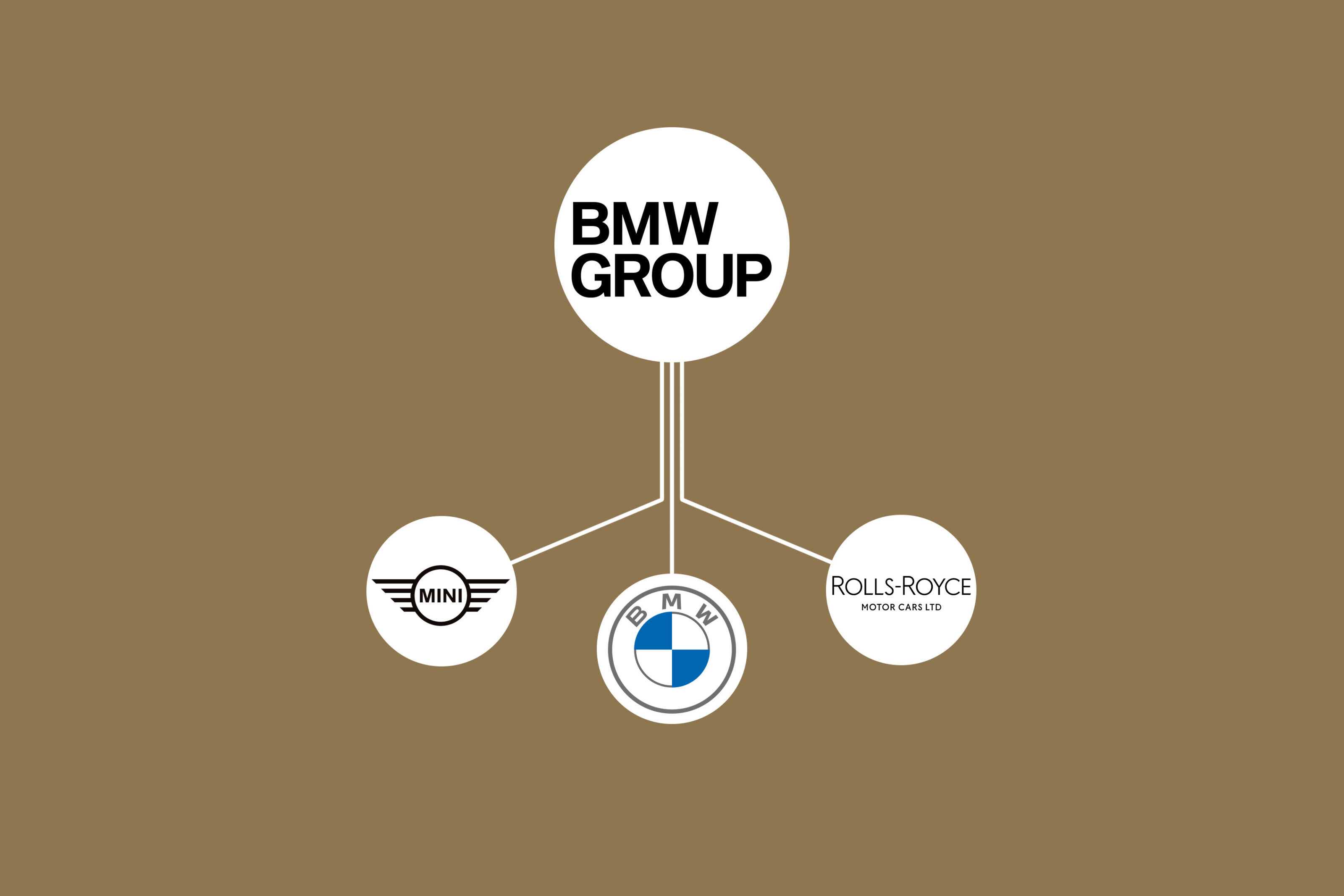
BMW – Founded 1916
Bavarian Motor Works celebrated its centenary in 2016 and has shareholders spanning most continents of the world.
Strategic investors hold shares of around 47 per cent of the luxury brand, while institutional investors from North America, the UK, Ireland, Germany and other parts of Europe hold a combined 40 per cent share.
Mini – Founded 1959
Mini was originally introduced as a model, founded by the British Motor Corporation, before becoming a marque in its own right in 1969. It has since changed hands several times by groups related to BMC until it was acquired by BMW in 1994.
Rolls-Royce – Founded 1906
Rolls-Royce is possibly the most highly regarded luxury car brand in the world. It also produces engines for commercial airliners, albeit as a separately operated company. Rolls-Royce was nationalised in 1971, then privatised in 1987.
It was later purchased by Volkswagen in 1998, before being acquired by BMW in 2003.
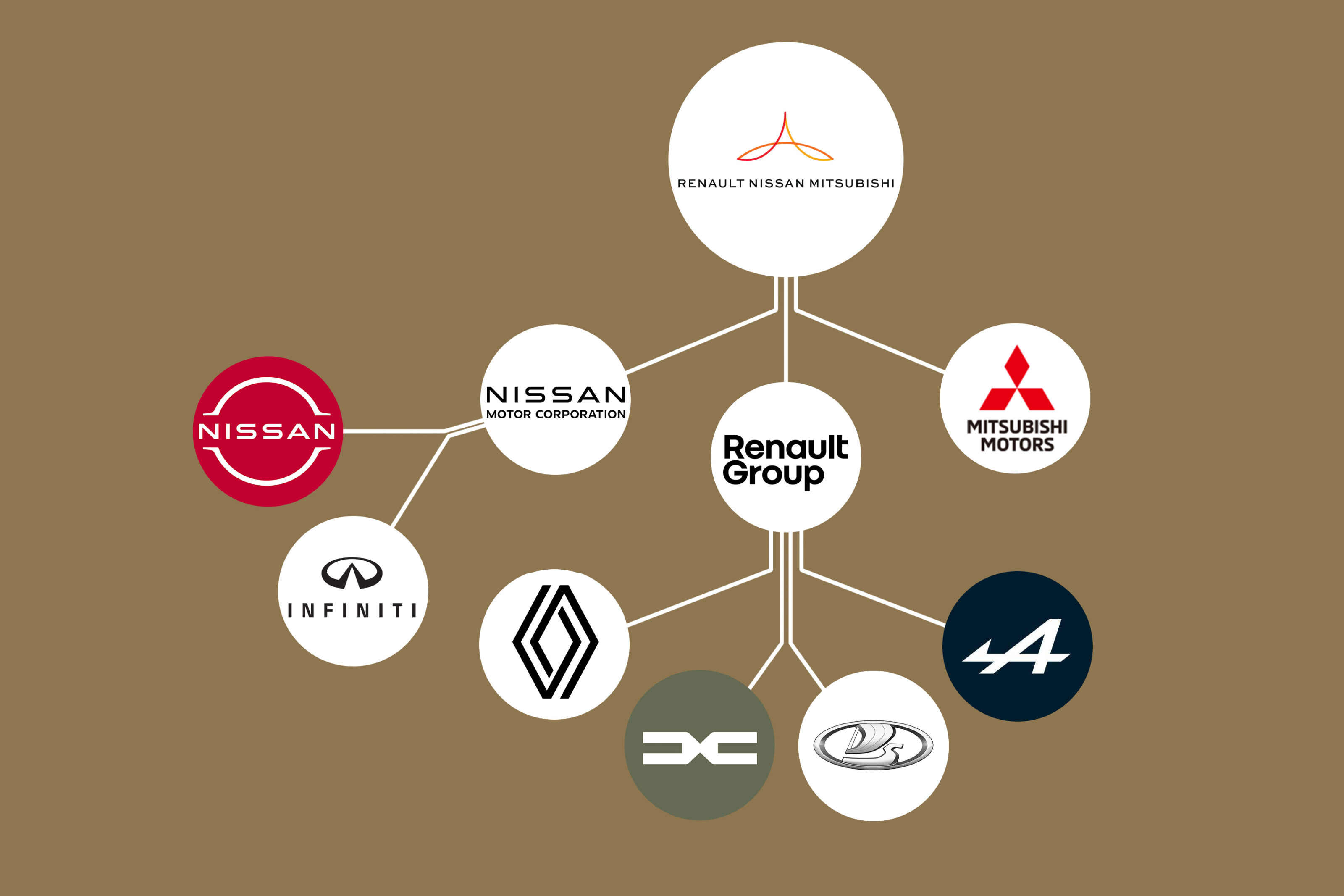
Renault-Nissan-Mitsubishi Alliance – Founded 1999
The seemingly unlikely alliance between Renault, Nissan and Mitsubishi was recently strengthened with a new framework ratified in early 2020.
Renault – Founded 1899
The French brand was set up at the end of the 19th century and has since grown to be one of the world’s most powerful and best-selling brands. The company is part-owned by the French Government (20 per cent), and itself has a 43 per cent controlling stake in Nissan.
Nissan – Founded 1933
The Japanese brand has been controlled by Renault since 1999 through the powerful Renault-Nissan Alliance, which sees Nissan hold a 15 per cent non-voting share in the French brand.
Nissan, in turn, holds Mitsubishi Motors as a subsidiary of its own, and Nismo stands as its in-house tuning brand.
Infiniti – Founded 1989
Infiniti is the luxury division of Nissan, producing various impressive models for Australia. Despite offering direct competition to Lexus for a number of years, the brand has failed to attract as much interest Down Under and announced it would pull out of the Australian market in 2019.
It was its second attempt on Australia’s discerning tastes, highlighting just how difficult and challenging the local landscape is for new brands – even with big brand backing.
Mitsubishi – Founded 1917
Mitsubishi was originally founded as a shipbuilder, with its dedicated motor division not emerging until 1970. The wider Mitsubishi brand still commands a 20 per cent stake in the company, but Nissan took a 34 per cent share in October 2016.
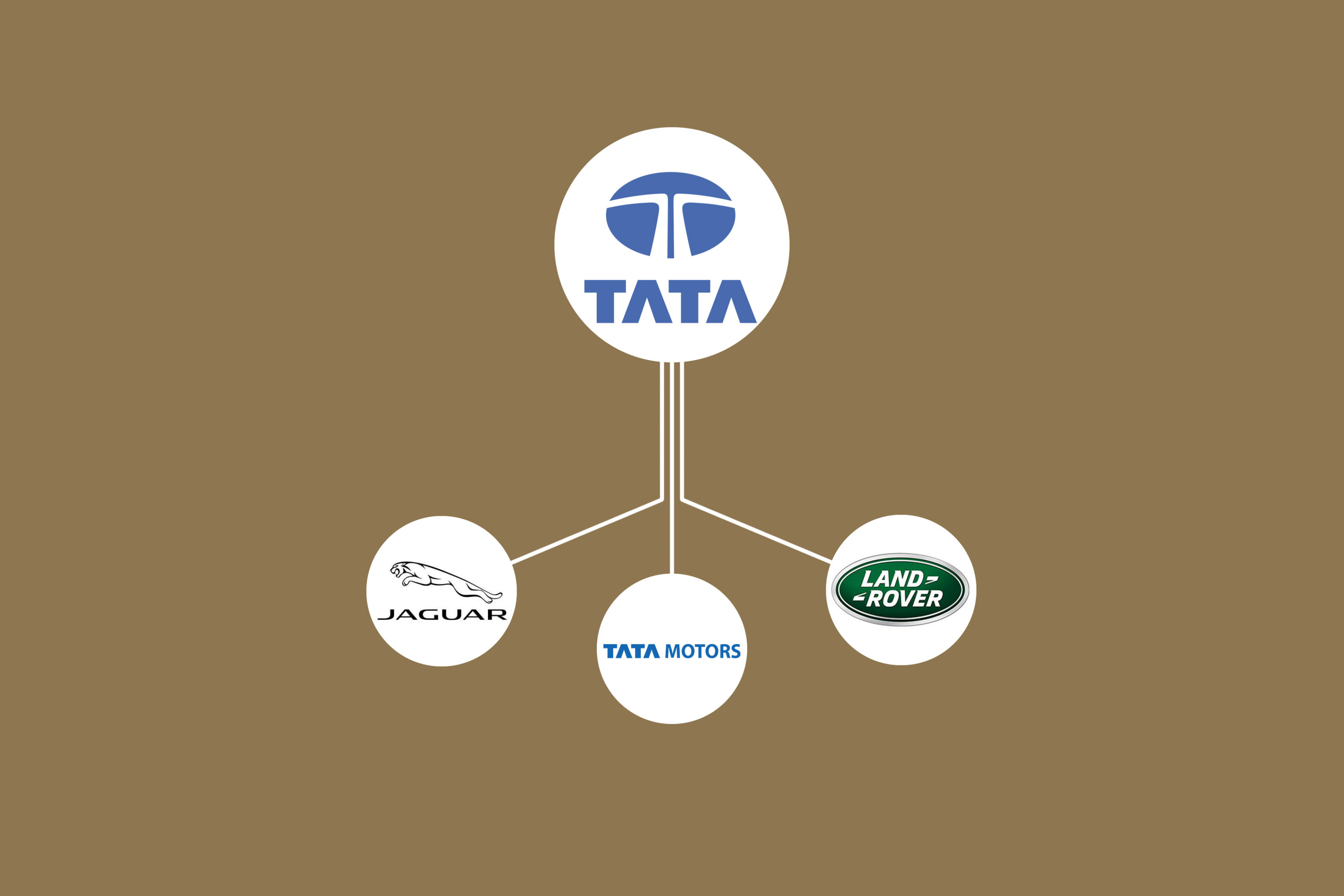
Tata Motors – Founded 1945
Tata is an Indian brand and part of the wider Tata conglomerate.
Between 1954 and 1969, the brand enjoyed a collaboration with Daimler-Benz. Jaguar Land Rover (JLR) was later purchased from Ford in 2008.
Land Rover – Founded 1948
Land Rover was acquired by Tata Motors in 2008, but is still revered as a British icon. Range Rover, in the meantime, has long been established (since 1970) as the brand’s flagship model range.
Jaguar – Founded 1922
Jaguar is a British luxury car brand previously controlled by Ford, from 1989 until 2008. Under Ford’s ownership, the brand never made a profit. In the wake of this failure and the Global Financial Crisis, Ford opted to sell it, along with Land Rover, to its current owner, Tata.
Both brands under the JLR umbrella have enjoyed a resurgence since Tata’s acquisition, with an explosion of new models and variants – as well as significant manufacturing investment including the Ingenium engine plant in the UK.
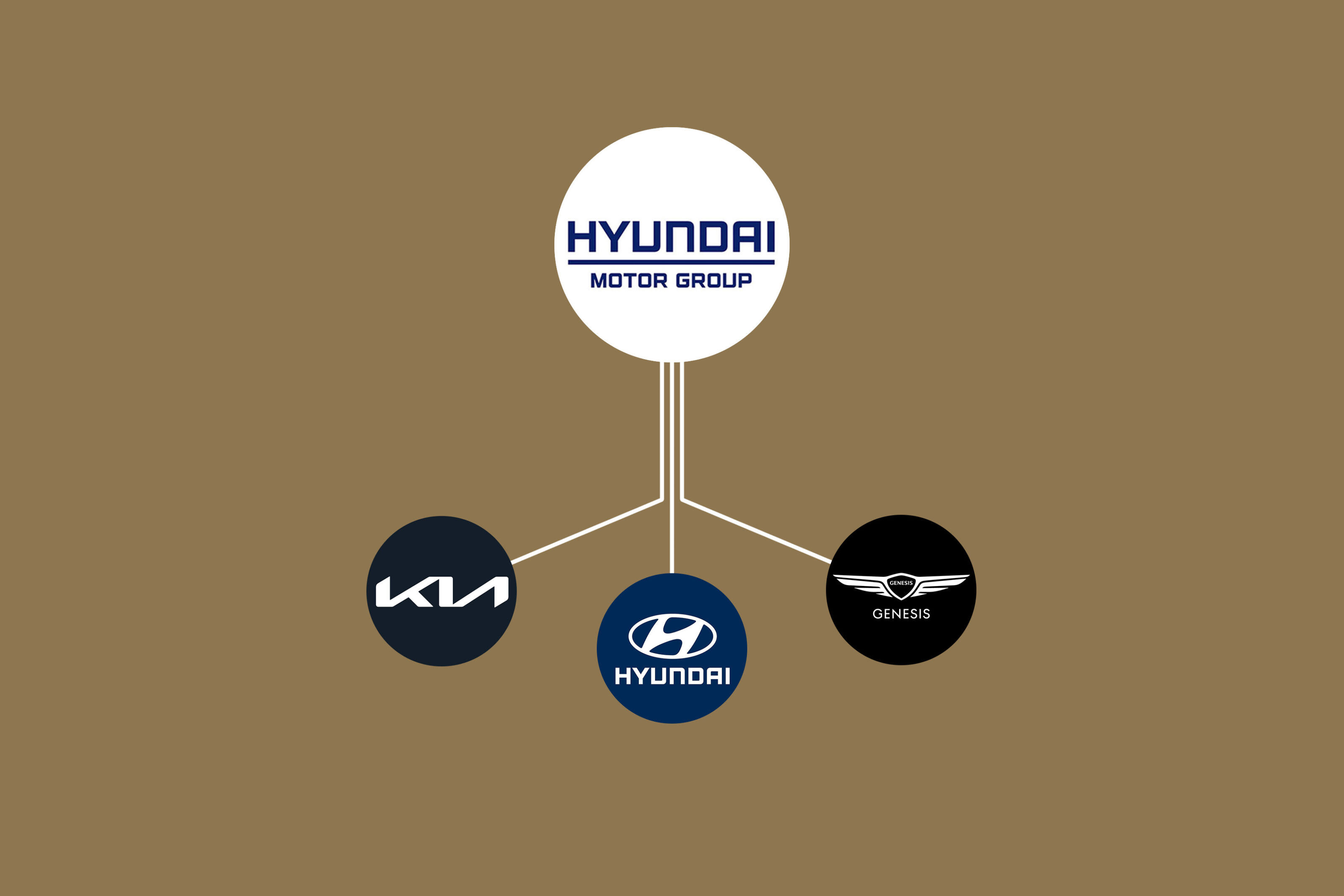
Hyundai – Founded 1967
Along with its 34 per cent owned subsidiary Kia, the Hyundai group is one of the world’s largest car makers.
The company continues to build inexpensive and relatively conservative cars for non-car enthusiasts but has more recently branched out into performance models to broaden its appeal, including its full-fat i30N hot hatch.
Kia – Founded 1944
The Hyundai-owned brand is similar to its parent in that it is based in South Korea and builds affordable and inoffensive cars, regularly going up against its parent company in the Australian sales race.
Kia was crippled in 1997 though, before being bailed out through an ownership exchange with Hyundai. Today, its quality and appeal are unrecognisable compared with some of the first offerings, and vehicles such as the Stinger high-powered sports coupe and electric EV6 continue to shatter preconceptions.
Genesis – Founded 2015
Genesis was originally Hyundai’s top of the range model. However, it has now evolved to become its own standalone marque.
Currently, it has a range of two high-performance sedans (G70, G80) and two SUVs (GV70, GV80).

Geely – Founded 1986
Geely is a Chinese car brand that has grown exponentially since it first started producing cars in 2002.
Selling a vast majority of its cars in China, the brand was able to purchase Volvo from Ford in 2010 and is preparing to conquer the western world with cars it hopes will appeal to more demanding requirements.
Volvo – Founded 1915
Originally a Swedish ball-bearing company, Volvo began manufacturing cars in 1927. It wasn’t until 1999 the Volvo group opted to sell its automobile division in order to focus on commercial vehicles.
Ford purchased the brand before going on to sell it to Geely in 2010.
Lotus – Founded 1948
Created by two university graduates, Lotus is a British low-volume sports car maker and, over the course of more than 70 years of history, has exclusively focused on performance cars that are lightweight and minimalist, based around founder Colin Chapman’s motto, “add lightness”.
Polestar – Founded 1996
Established as Volvo’s performance and racing division, Polestar was officially sold to the Swedish company in 2015, with the racing operations being renamed to Lynk & Co which utilises a mix of Geely and Volvo hardware in its vehicles.
Polestar is now a dedicated EV manufacturer, creating the Polestar 1, 2 and 3 which share some hardware with Volvo products. The Polestar 2 went on sale in Australia at the start of this year with the local business structure being announced in mid-2021.
Geely also owns 49.9% of Malaysia’s Proton, no longer sold in Australia.

Mahindra – Founded 1945
Originally formed as a steel trading company by two Indian brothers, Mahindra began assembling the Willys Jeep on the subcontinent in 1947 before exporting its vehicles in 1969.
Mainly a manufacturer of agricultural products and vehicles, Mahindra’s first vehicle, the Scorpio, was released to the world in 2002 with its XUV500 SUV becoming the first model to arrive in Australia, landing in 2013.
Pininfarina – Founded 1930
Italian automotive styling house Pininfarina is best known for its long-held association with Ferrari, designing iconic models such as the Testarossa, F40, F50, 550 Maranello and 458 to name a few.
A deal was struck in 2015 for the Mahindra Group to take a 76 per cent stake in Pininfarina, although the company still operates out of its base in Turin, Italy.
Automobili Pininfarina – Founded 2018
This is where things may get a little confusing. While the Mahindra Group has a majority stake in Pininfarina, Automobili Pininfarina is a separate entity and is a subsidiary of Mahindra’s automotive arm, having been founded as a luxury EV manufacturer.
Its one car in production is named the Battista, based on the underpinnings of Rimac’s Nevara hypercar, producing 1400kW and 2300Nm from its four motors, one for each axle.
SsangYong – Founded 1954
Starting out as Ha Dong-hwan Motor Workshop in 1954, a merger with Dongbang Motor Co in 1963 led to SsangYong (then Ha Dong-hwan Motor Co) producing Willys Jeeps for the US Army before being eventually taken over by Ssangyong Business Group in 1986.
SsangYong Motors entered a partnership with Daimler-Benz in 1991 which led to the development of the Musso SUV, a South Korean vehicle underpinned by Mercedes-Benz equipment. Merc’s hardware continued to be used in the badge-engineered MB100 van as well as the Ssangyong Korando.
After a stint under Daewoo and SAIC ownership from 1997 to 2010, Mahindra acquired the brand at a cost of US$463.6 million (AU$628m). Despite filing for bankruptcy in the back end of 2020, SsangYong continues to operate in Australia, selling the Rexton and Korando SUVs as well as the Musso ute.
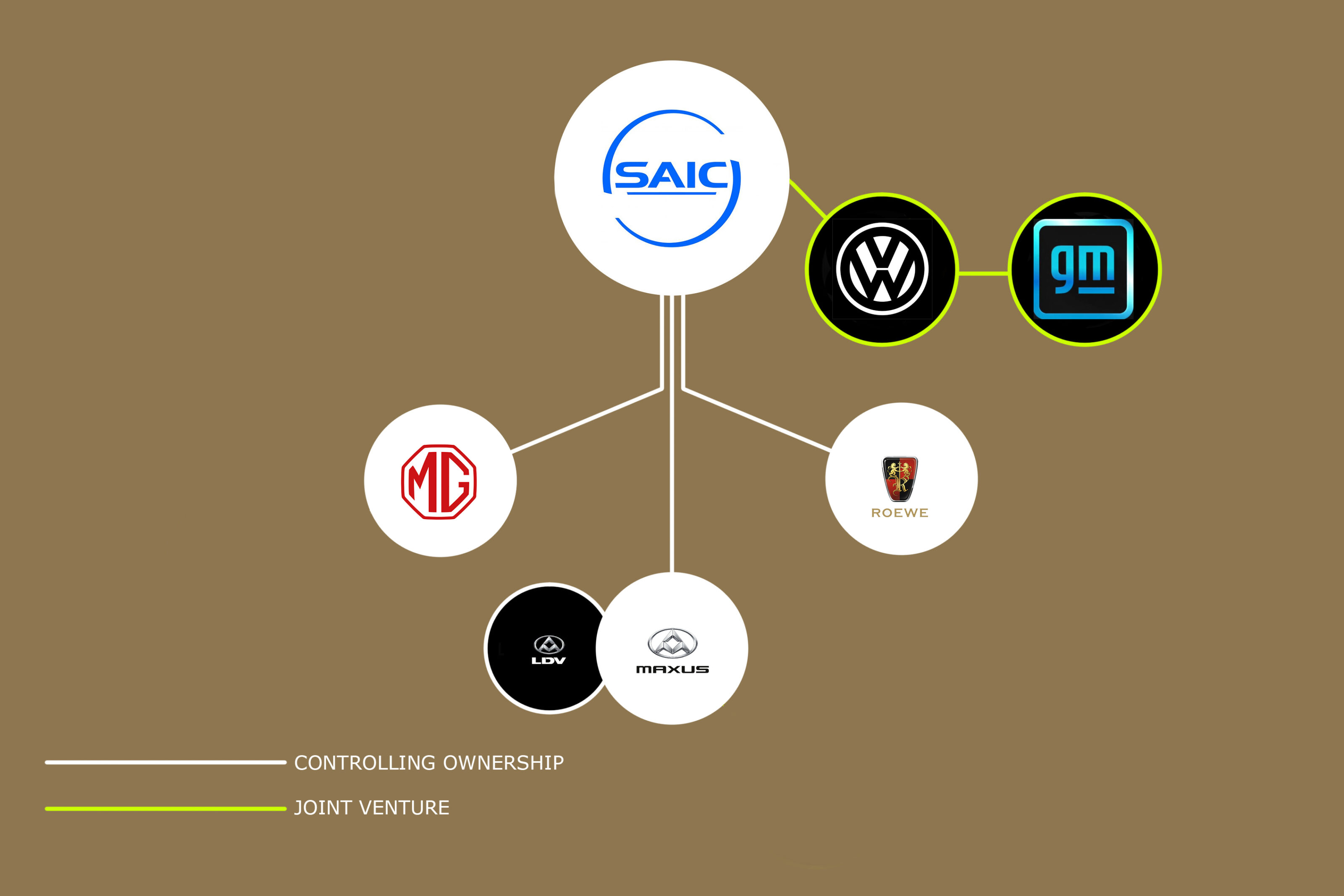
SAIC Motor – Founded 1955
Formerly known as the Shanghai Automotive Industry Corporation, SAIC is one of the big-four state-owned carmakers in China and is the country’s largest by volume, producing more than 5.81 million cars in 2021.
Its initial growth was due to a surge in demand for cars in China during the 1980s, which saw it enter a joint venture agreement with Volkswagen and another with General Motors in 1998. Both partnerships are still in place today with SAIC producing Cadillac, Chevrolet, Buick, Volkswagen Skoda and Audi badged vehicles.
It is also the parent company of MG Motor, Roewe, and Maxus, which trades in Australia as LDV.
MG Motor – Founded 1920
Famous for its two-seat roadsters, MG changed hands several times in eight decades, before the MG Rover Group went into receivership in 2005.
The marque was revived in April 2006 when Chinese carmaker Nanjing Automobile acquired the MG Rover plant and established NAC MG UK Limited.
Nanjing Automobile was acquired by SAIC Motor in 2007 and in early 2009 NAC MG UK Limited was renamed MG Motor. The company continued building MG Rover models with limited success until June 2011 when it launched the first all-new MG-branded model in 16 years, the MG6.
Maxus – Founded 2011
Like MG, Maxus has UK roots, with the brand originating from the LDV Maxus van as a result of SAIC acquiring the intellectual property to the vehicle from the now-defunct LDV in 2010.
Maxus now builds a range of commercial vehicles and people movers including the V80 and V90 vans, G80 MPV, T60 ute and D Series SUV, which are sold in Australia under the LDV brand.
LDV – Founded 1896
LDV is no longer a vehicle manufacturer but, as mentioned above, the brand entered Chinese hands in 2010 when SAIC acquired the intellectual property for the LDV Maxus van. It adopted the Maxus name for its commercial vehicle arm, but uses LDV branding in its traditional markets such as the UK, Ireland, Australia and New Zealand.
LDV originated from Leyland, which sold off its trucks and van divisions in 1987 to form Leyland DAF, a merger between the Rover Group and Dutch manufacturer DAF Trucks. That venture lasted all of six years, with the company going into receivership and split four ways, one being the newly established LDV Group. That too went into administration in 2005 and was acquired by the Russian GAZ Group in 2006 whose grand plans never eventuated.
The receivers swooped again in 2008 and the company and its Birmingham factory finally folded. SAIC’s purchase of the intellectual property rights saw the LDV marque reunited with its old Leyland and Rover stablemate MG.
Roewe – Founded 2006
Roewe is another SAIC entity that stems from MG Rover, with its vehicles initially built using technology acquired from the UK carmaker. But while SAIC was able to secure the rights to the MG name it had less luck with Rover – BMW which held the rights sold them to Ford, which returned them to Jaguar Land Rover.
Roewe is apparently a transliteration of Rover, although SAIC has stated that it is derived from Löwe, the German word for lion, which is pronounced much like Roewe by Chinese speakers. It’s worth noting the similarity between the Roewe and Rover badges.
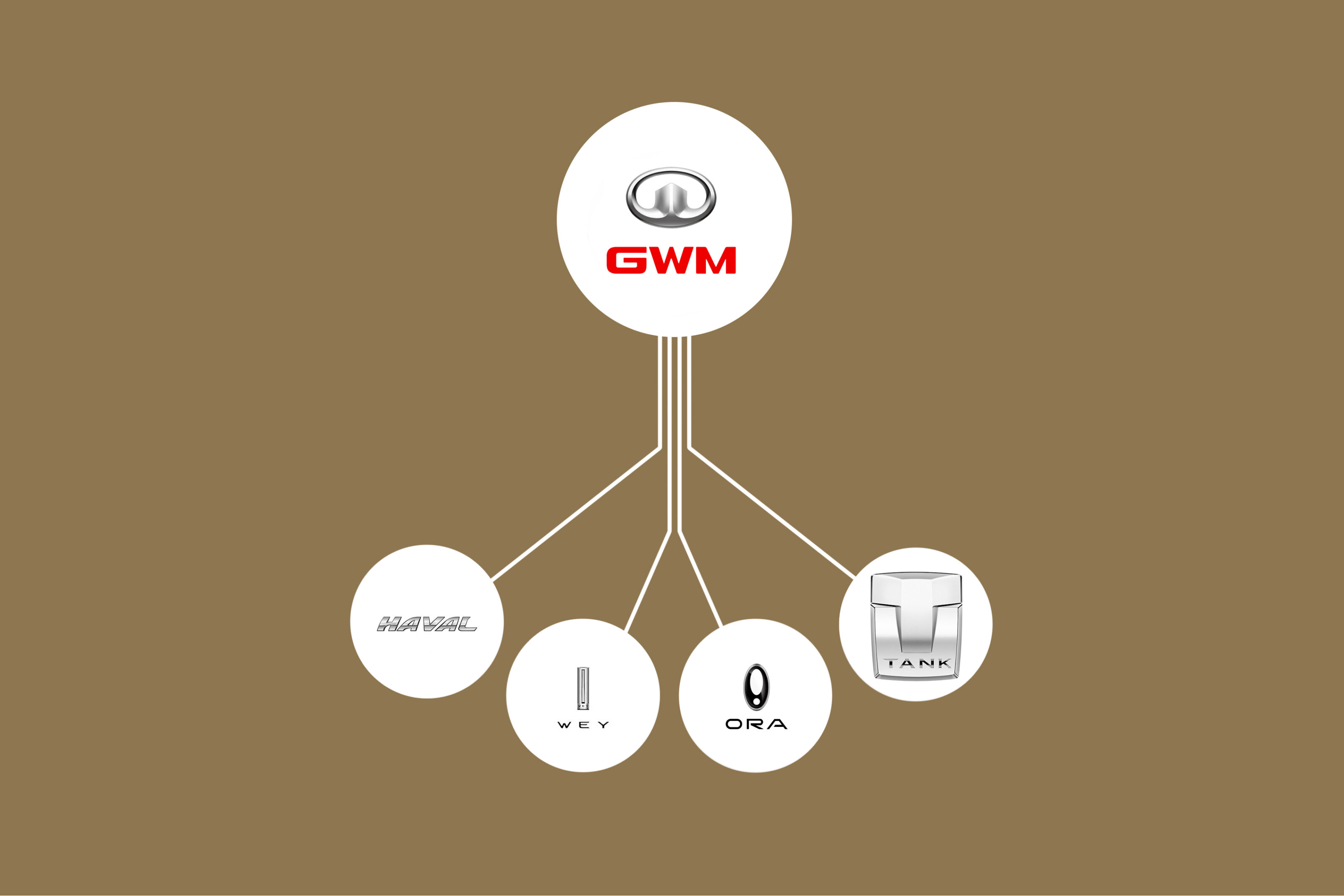
GWM – Founded 1984
Privately-owned Great Wall Motor, know known as GWM, is the eighth biggest automobile manufacturer in China.
GWM sold 1.281 million vehicles in 2021 under its own branding and its Haval, Wey, Tank, Poer, and Ora brands.
In Australia, GWM sells models from each of the brands listed here, with the GWM badge appearing before each.
Haval – Founded 2013
Haval has come leaps and bounds since it was founded less than 10 years ago to become one of China’s biggest manufacturers of SUVs and electrified vehicles. Its 2021 global sales exceeded 770,000.
Wey – Founded 2016
WEY is GWM’s luxury brand that builds premium SUVs based on Haval models. Its moniker stems from GWM’s chairman Wei Jianjun’s name, which is pronounced the same way.
Ora – Founded 2018
Ora, which stands for ‘open, reliable and alternative’ specialises in compact electric vehicles with feline nomenclatures, such as the White Cat city car and the Punk Cat, which is VW Beetle lookalike.
Tank – Founded 2021
The first Tank model, the Tank 300, initially went on sale under the Wey brand in December 2021. Three months later Tank became GWM’s newest brand, specialising in rugged off-road vehicles.
Standalone brands
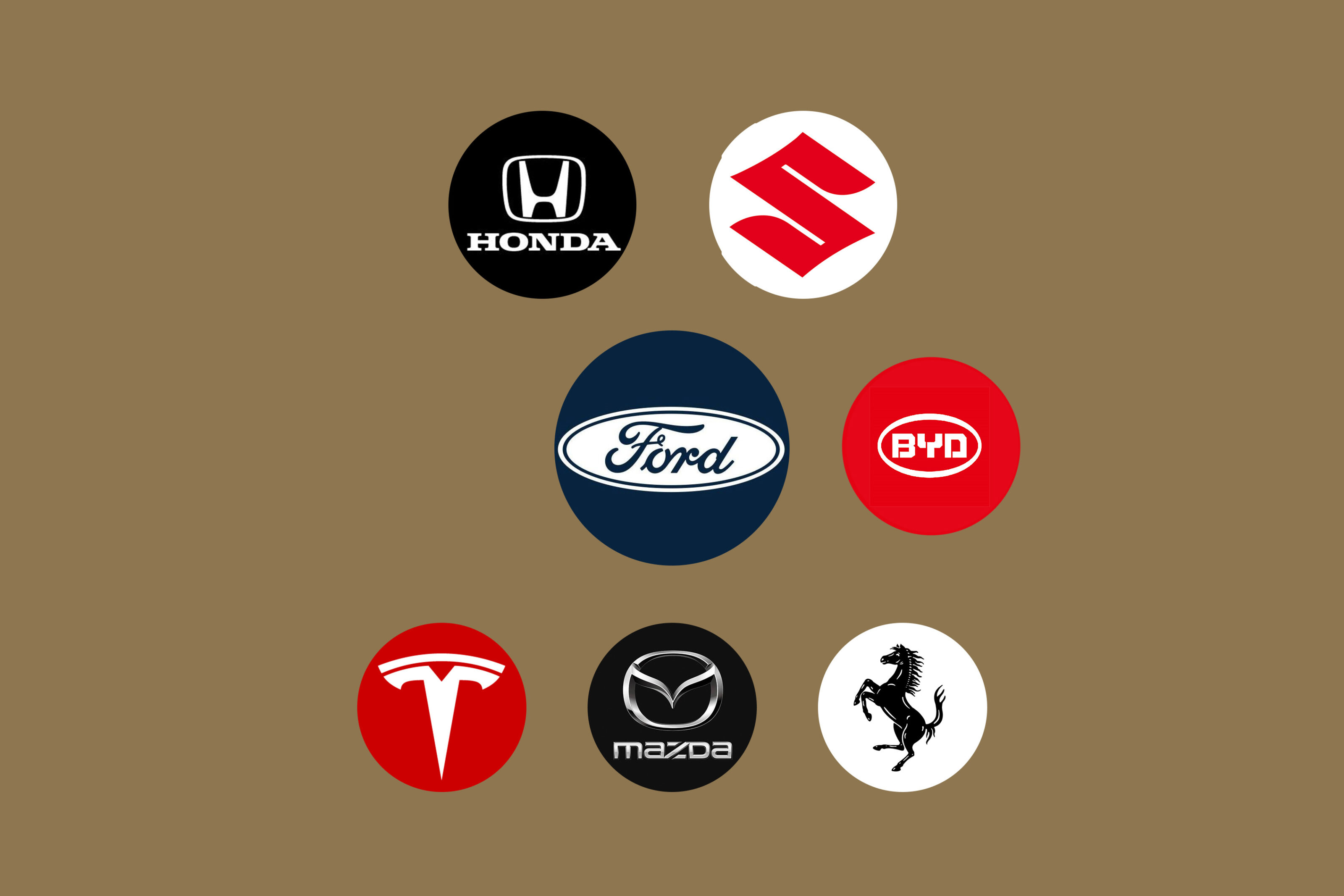
Ford – Founded 1903
Ford at different times has maintained control of various other car brands, but at present only holds a small stake in both Aston Martin and Mazda (eight and 2.1 per cent respectively).
Having operated in Australia from 1925, Ford ended manufacturing locally in 2016, signalling the death of the Falcon and Territory nameplates.
Ford also owns the Lincoln premium brand, which is not sold in Australia.
Honda – Founded 1946
As well as the world’s leading motorcycle producer, Honda is one of the largest car manufacturers.
The brand continues to work independently of other car brands, apart from its Acura luxury indent sold in some markets such as North America.
Suzuki – Founded 1909
Despite holding limited traction in the Aussie car market, Suzuki is a major player on the world stage.
At one point Volkswagen held a 19.9 per cent share of the brand (between 2009 and 2015), but Suzuki later purchased it back. Toyota currently owns a 4.94% stake in Suzuki.
Mazda – Founded 1920
Mazda was owned for a short time by Japanese banks and Ford, but Mazda has continued to, for the most part, guide its own destiny.
At the height of Ford’s ownership in 1996, it held a 33.3 per cent stake. Toyota currently owns a 5.1% stake in Mazda.
Ferrari – Founded 1939
The prancing horse has long been known as one of the world’s most influential brands, despite never selling large volumes.
For a significant chunk of its history, Fiat owned a 50 per cent stake in Ferrari between 1969 and 2014 before the brand was eventually spun off in 2016 for maximum shareholder value.
Subaru – Founded 1953
Best known for its boxer engines, rally success and commitment to all-wheel drive system development, the Subaru brand has earned a loyal following in Australia and is a consistent top ten seller.
Before the more conventional dealership model of today, Subarus were initially sold through agricultural machinery suppliers – one of the reasons the brand is still popular with farming communities to this day.
Toyota currently owns a 20% stake in Subaru.
Tesla – Founded 2003
The purveyor of electric cars, Tesla builds EVs in the US and China. It also builds batteries for home use and is branching into solar roof tiles.
Tesla is led by former PayPal owner Elon Musk, who also founded SpaceX.
BYD Auto – Founded 2003
BYD stands for Build Your Dreams, and the Chinese maker of vehicles and batteries is doing just that.
BYD Auto was founded in 2003 when the parent company BYD acquired the Qinchuan Automobile Company and attracted plenty of attention when the Warren Buffett-led Berkshire Hathaway took a US$232 million stake in the parent company
BYD Auto produces a wide range of vehicles including cars, buses and trucks, many of which have plug-in models, making it the fourth-largest BEV company in the world. In 2022 its Atto 3 SUV will go on sale in Australia.
We recommend
-
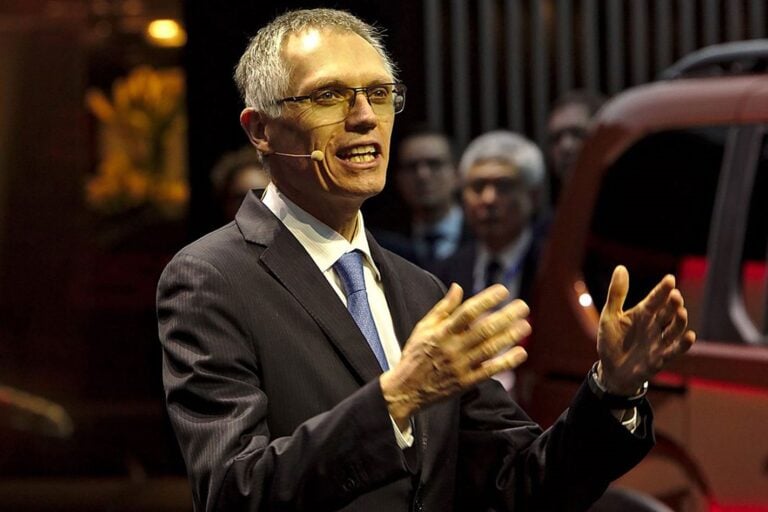 News
NewsStellantis boss believes semi-conductor shortage will continue into 2022
The worldwide chip supply issue is projected to drag on into next year
-
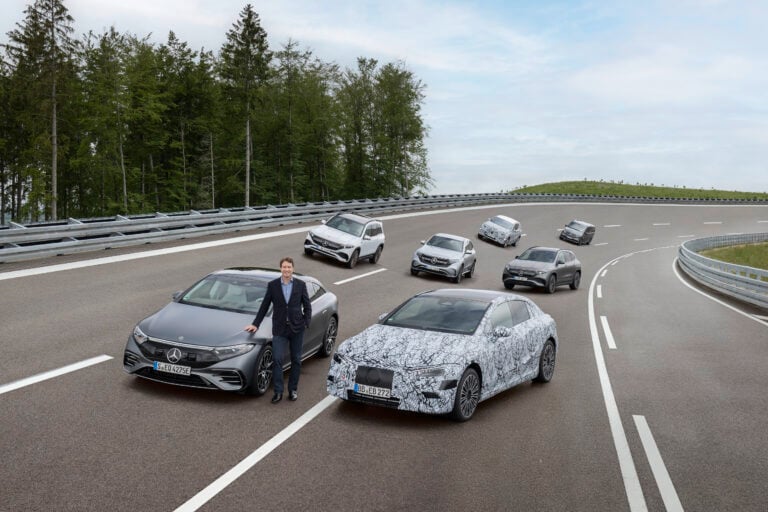 News
NewsMercedes-Benz to become fully-electric by 2030 – but with one condition
The world's first automotive manufacturer will be making sizeable investments to remain on-track for its target
-
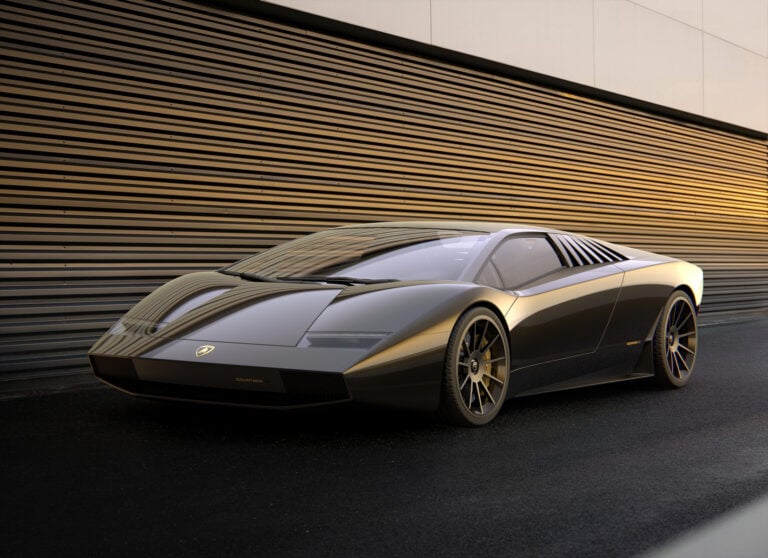 News
NewsARC Design reimagines the Lamborghini Countach for its 50th birthday
Fifty years on from its debut at the 1971 Geneva Motor Show, Lamborghini's iconic Countach has been given a birthday treat by an independent artist



